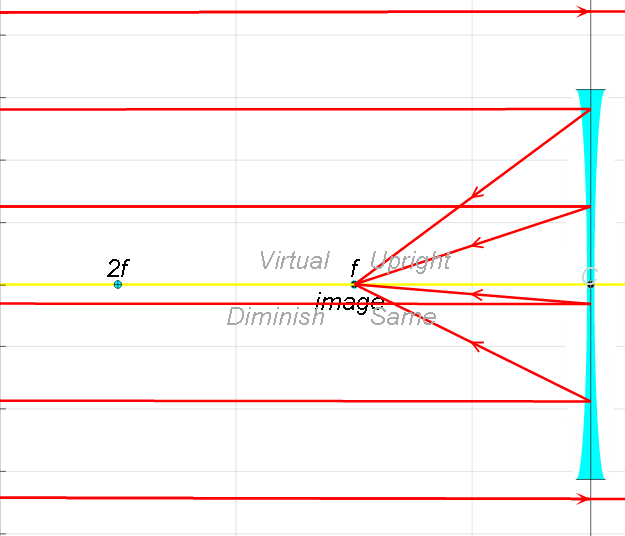'Ray Optics'
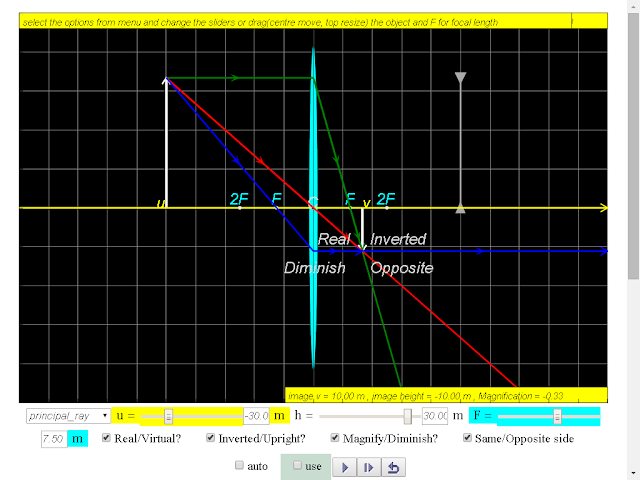 |
| http://weelookang.blogspot.sg/2015/05/ejss-thin-converging-diverging-lens-ray.html EJSS Thin Converging Diverging Lens Ray Diagram Lens Inquiry Learning Model authors: Fu-Kwun Hwang; lookang run:https://dl.dropboxusercontent.com/u/44365627/lookangEJSworkspace/export/ejss_model_ThinLenModel05/ThinLenModel05_Simulation.xhtml offline: https://dl.dropboxusercontent.com/u/44365627/lookangEJSworkspace/export/ejss_model_ThinLenModel05.zip source: https://dl.dropboxusercontent.com/u/44365627/lookangEJSworkspace/export/ejss_src_ThinLenModel05.zip |
| http://weelookang.blogspot.sg/2009/07/ejs-open-source-converging-diverging.html EJS Thin Converging Diverging Lens Ray Diagram Lens Inquiry Learning Model authors: Fu-Kwun Hwang; lookang http://www.phy.ntnu.edu.tw/ntnujava/index.php?topic=1155.0 download: http://iwant2study.org/lookangejss/04waves_13light/ejs/ejs_model_ThinLenModel02.jar |
Changes:
- redesign the way the rays are drawn according to JavaScript capabilities
- added play step reset to animate dp/dt = vp = 1 or -1 to show the effects of changing p, distance of object to lens
- all rays are how showing the light travels in straight line when no lens is between
- added new pictures from Wikipedia licensed CC-BY or Public, attribution added on pictures
- redesign the layout
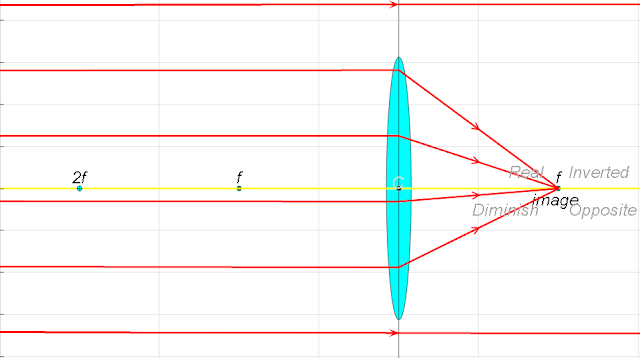 |
| Incoming parallel rays are focused by a convex lens into an inverted real image one focal length from the lens, on the far side of the lens http://weelookang.blogspot.com/2015/05/ejss-thin-converging-diverging-lens-ray.html |
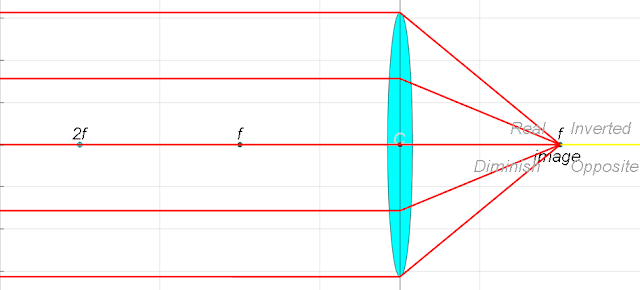 |
| Incoming parallel rays are focused by a convex lens into an inverted real image one focal length from the lens, on the far side of the lenshttp://weelookang.blogspot.com/2015/05/ejss-thin-converging-diverging-lens-ray.html |
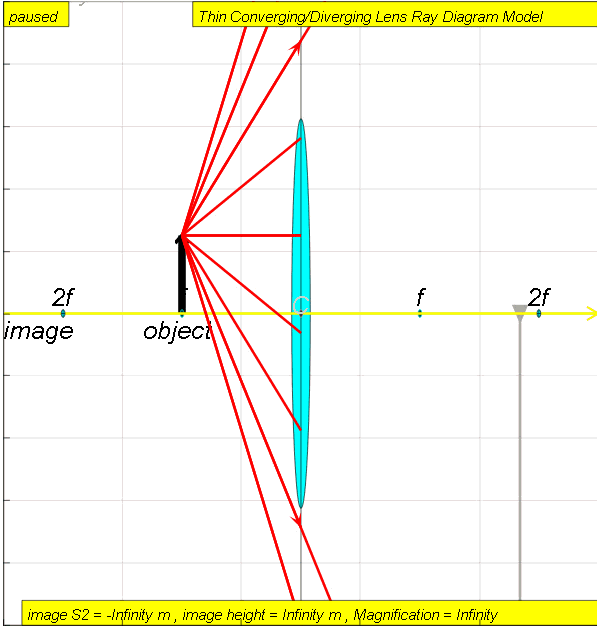 |
| Rays from an object at finite distance are associated with a virtual image that is closer to the lens than the focal length, and on the same side of the lens as the object. |
Exercises:
designed by lookang 
1. Explore the simulation. Notice that you can move the sliders to vary the distance of the object to the centre of the thin len. What do each of the buttons and sliders do?
2. Take about 10 minutes to inquiry through the simulation model and describe the action of a thin converging lens on a beam of light. ( this simulation currently does not have beam of light)
3. Discuss with your lab partner what is the meaning of the focal length f.
* hint: in terms of the way the light rays from the object is bend and pass through where?
4. check the principal rays radio button. Discuss and formulate ideas how the ray diagram allows the drawing of ray diagrams to illustrate the formation of real and virtual images of an object by a
thin converging lens.
* What does the green ray light always do?
* What does the red ray light always do?
* What does the teal ray light always do?
o hint: in terms of the way ray light traveling parallel to and passing through where etc?
5. What does the term linear magnification mean in this simulation.
* Discuss how it is calculated from?
* How many ways are there to determine the magnification of the think converging len.
6. Check the no ray radio button. move the sliders a suitable position of your choice. Now, sketch as accurately as possible on a piece of paper, the principal ray diagram ( minimum 2 rays) to get the image position and height. Practice a few times with different and varied examples to allow you to draw scale diagrams to deduce the focal length needed for particular values of magnification (converging lens only)
7. explore the simulation to make observations of the use of a single converging lens as a
* magnifying glass a
* projector
8. Draw rays of examples for each case to show clearly how each forms an image
http://www.youtube.com/watch?v=lt-UxbopEUY
There is a video that narrates some of the ideas in the simulation as well
Designed by Fu-Kwun Hwang http://www.phy.ntnu.edu.tw/ntnujava/ remixed by welookang@gmail.com for K12 physics "Thin Converging Lens Ray Diagram"
reference: http://www.phy.ntnu.edu.tw/ntnujava/index.php?topic=704 hosted: http://www.phy.ntnu.edu.tw/ntnujava/index.php?topic=1155.0
Ejs open source converging & diverging thin convex Lens object image high school java applet. now able to allow for inquiry learning of
physics Images formed by a converging lens object distance equal f
physics Images formed by a converging lens object distance greater than 2 focus length
physics Images formed by a converging lens object distance lesser than f
physics Images formed by a converging lens object distance equal to 2 focus length
physics Images formed by a converging lens object distance between f and 2f
This thin lens ray diagram java applet has:
Main view:
Lens that is controllable by the focal length f, +f imply converging lens -f imply diverging lens.
Focal points drag-able, 2F, F, F & 2F
u is position of Object from lens center c
v is position of Image from lens center c.
The object is drag-able to the right side of the lens
Top View:
dynamically display a possible use of the lens under different conditions with pictures shared under creative commons licenses and other similar pro usage licenses under attribution.
Bottom View:
4 radio buttons: allows for different visualization purposes of light path in the context of lens
no ray
principal ray
marginal ray
all ray
4 check boxes:
"Real/Virtual?"
"Inverted/Upright?"
"Magnify/Diminish?"
"Same/Opposite side"
Autoscale: to allow visualization view of images formed outside designed screen view.
3 slider control:
u, object distance from c
h, height of object
f, focal length of lens
3 values display:
v, image distance from c
ih, image height
M, Magnification
PHYSICS
GCE Advanced Level
(Syllabus 9246)
http://www.seab.gov.sg/SEAB/aLevel/syllabus/2009_GCE_A_Level_Syllabuses/9246_2009.pdf
distinguish between converging and diverging lenses and show an understanding of the
significance of focal length.
5056 PHYSICS O LEVEL (2009)
http://www.seab.gov.sg/SEAB/oLevel/syllabus/2009_GCE_O_Level_Syllabuses/5056_2009.pdf
(i) describe the action of a thin converging lens on a beam of light
(j) define the term focal length
(k) *draw ray diagrams to illustrate the formation of real and virtual images of an object by a
thin converging lens
(l) define the term linear magnification
(m) *draw scale diagrams to deduce the focal length needed for particular values of
magnification (converging lens only)
(n) describe the use of a single lens as a magnifying glass and in a projector and draw ray
diagrams to show how each forms an image
List of other simulations
found some popular lens java applet1. http://www.phy.ntnu.edu.tw/ntnujava/index.php?topic=48
Likes: the white screen to illustrate possible focus image and blur images?
Likes: most popular java applet hosted all around the world
2. http://phet.colorado.edu/simulations/sims.php?sim=Geometric_Optics
Likes: the white screen to illustrate possible focus image and blur images?
Likes: the option for no rays, principal rays, marginal, all rays to allow for sense making?
Likes: the move me! bouncing hints
Likes: movable principal axis lens to reposition lens
3. http://surendranath.tripod.com/Applets/Optics/ReflRefrCurv/CurvSurfApplet.html
4. http://webphysics.davidson.edu/physlet_resources/dav_optics/examples/eye_demo.html
Likes: fantastic for explaining eye lens
http://www.physics.uoguelph.ca/applets/Intro_physics/kisalev/java/clens/index.html
http://webphysics.davidson.edu/course_Material/Py230L/optics/lenses.htm
Like: the beam function
Like: Mirror
Like: Aperture
